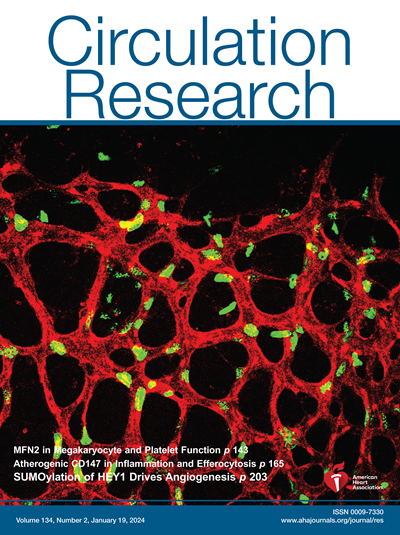减少颗粒而不恢复剪接可减轻RBM20心肌病。
IF 16.5
1区 医学
Q1 CARDIAC & CARDIOVASCULAR SYSTEMS
引用次数: 0
摘要
drbm20 (RNA结合基序蛋白20)心肌病是扩张型心肌病(DCM)的一种严重形式。Rbm20核定位信号的遗传变异阻碍其核输入,促进细胞质致病性RNP(核糖核蛋白)颗粒。我们的目的是研究通过抑制Rbm20的表达来减少RNP颗粒是否可以减轻Rbm20S639G (Rbm20S639G)敲入小鼠的DCM表型。方法利用特异性抑制Rbm20表达的反义寡核苷酸(ASOs)下调Rbm20的表达。我们在RBM20的核定位信号中携带丝氨酸到甘氨酸取代的Rbm20S639G小鼠中给予RBM20 - asos。在发病前的幼龄(14日龄)小鼠和已建立DCM表型的成年(3月龄)小鼠中,以25 mg/kg的剂量皮下注射Rbm20-ASOs,每周1次,持续8周。通过超声心动图评估体内心功能。荧光免疫组化染色鉴定RNP颗粒,使用Cell Profiler软件定量RNP颗粒的数量和大小。逆转录聚合酶链反应测定RBM20靶基因的选择性剪接,凝胶电泳分析titin异构体的表达。还研究了心肌细胞Ca2+释放-再摄取动力学和小鼠心电图。结果通过ASOs处理降低Rbm20表达水平可显著降低Rbm20S639G心肌细胞胞质RNP颗粒。ASO治疗降低了发病前开始治疗的DCM的严重程度。重要的是,ASO治疗在DCM小鼠治疗开始时逆转了心功能障碍和重构,射血分数显著改善,左心室扩张严重程度降低。ASOs治疗还能有效缓解左室肥厚重塑,改善心电图参数,如P波和QRS持续时间。这些有益的效果发生在不恢复RBM20靶基因的错误剪接的情况下,包括主要靶基因Ttn和其他基因,如Camk2d, Ryr2和Ank3。结论本研究结果表明,RNP颗粒是RBM20心肌病的关键驱动因素,通过ASOs治疗RNP颗粒减少是在核定位信号区携带RBM20基因变异的患者RBM20心肌病的可能治疗选择。本文章由计算机程序翻译,如有差异,请以英文原文为准。
Reducing Granules Without Splicing Restoration Alleviates RBM20 Cardiomyopathy.
BACKGROUND
RBM20 (RNA binding motif protein 20) cardiomyopathy is a severe form of dilated cardiomyopathy (DCM). Genetic variants in the nuclear localization signal of Rbm20 hinder its nuclear import and promote cytoplasmic pathogenic RNP (ribonucleoprotein) granules. We aimed to investigate whether reducing RNP granules by inhibiting Rbm20 expression could alleviate the DCM phenotype in Rbm20 S639G (Rbm20S639G) knock-in mice.
METHODS
We downregulated Rbm20, utilizing antisense oligonucleotides (ASOs) that specifically inhibit Rbm20 expression. We administered Rbm20-ASOs in Rbm20S639G mice that carry a serine-to-glycine substitution in the nuclear localization signal of RBM20. The Rbm20-ASOs were administered subcutaneously at 25 mg/kg once a week for 8 weeks in both young (14-day-old) mice before the onset of DCM and adult (3-month-old) mice with established DCM phenotype. In vivo cardiac function was assessed by echocardiography. RNP granules were identified through fluorescent immunohistochemical staining, and the number and size of RNP granules were quantified using Cell Profiler software. Alternative splicing of RBM20 target genes was determined by reverse transcription polymerase chain reaction, and titin isoform expression was analyzed by gel electrophoresis. Cardiomyocyte Ca2+ release-reuptake kinetics and mouse electrocardiography were also studied.
RESULTS
The results revealed that reducing the level of Rbm20 expression through treatment with ASOs significantly decreased the cytoplasmic RNP granules within the Rbm20S639G cardiomyocytes. ASO treatment reduced the severity of DCM developed when treatment was initiated before the onset of the disease. Importantly, ASO treatment reversed cardiac dysfunction and remodeling when treatment was commenced in mice with established DCM as shown by a significant improvement in ejection fraction and a decrease in the severity of left ventricular chamber dilation. Treatment with ASOs also effectively mitigated left ventricular hypertrophic remodeling and improved ECG parameters observed as normalized P wave and QRS durations. These beneficial effects occur without the restoration of mis-splicing of RBM20 target genes, including the primary target gene Ttn, and other genes such as Camk2d, Ryr2, and Ank3.
CONCLUSIONS
The findings of this study demonstrated that RNP granules serve as a critical driver for RBM20 cardiomyopathy, and reduction of RNP granules through treatment with ASOs is a possible therapeutic option for RBM20 cardiomyopathy in patients carrying RBM20 genetic variants in the nuclear localization signal region.
求助全文
通过发布文献求助,成功后即可免费获取论文全文。
去求助
来源期刊

Circulation research
医学-外周血管病
CiteScore
29.60
自引率
2.00%
发文量
535
审稿时长
3-6 weeks
期刊介绍:
Circulation Research is a peer-reviewed journal that serves as a forum for the highest quality research in basic cardiovascular biology. The journal publishes studies that utilize state-of-the-art approaches to investigate mechanisms of human disease, as well as translational and clinical research that provide fundamental insights into the basis of disease and the mechanism of therapies.
Circulation Research has a broad audience that includes clinical and academic cardiologists, basic cardiovascular scientists, physiologists, cellular and molecular biologists, and cardiovascular pharmacologists. The journal aims to advance the understanding of cardiovascular biology and disease by disseminating cutting-edge research to these diverse communities.
In terms of indexing, Circulation Research is included in several prominent scientific databases, including BIOSIS, CAB Abstracts, Chemical Abstracts, Current Contents, EMBASE, and MEDLINE. This ensures that the journal's articles are easily discoverable and accessible to researchers in the field.
Overall, Circulation Research is a reputable publication that attracts high-quality research and provides a platform for the dissemination of important findings in basic cardiovascular biology and its translational and clinical applications.
 求助内容:
求助内容: 应助结果提醒方式:
应助结果提醒方式:


